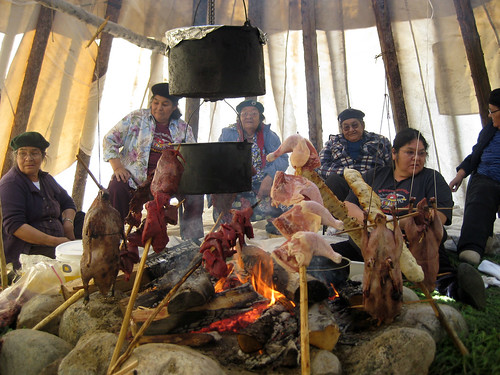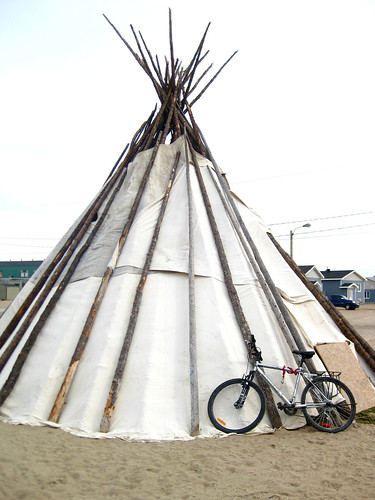While I’ve been nearly absent from Spacing Montreal in the past 2-3 months, I’ve been working in two Cree communities in Northern Quebec. One of the towns I got to know was Great Whale, also called Kuujjuarapik among the Inuit residents and Whapmagoostui by the Cree. The community of about 1500 is tucked between the Hudson Bay and the Great Whale river and, like much of Northern Quebec and Canada, it is only accessible by plane.
Although I’ve been hearing echoes about the Turcot controversy, future metro extensions, and incoherent highway planning, I’ve been experiencing first hand what life it like for those with no roads at all. So, with the intent of reflecting a little on how our lives are shaped by transportation infrastructure, here are a few notes on the ups and and downs of living beyond the highway’s end:
– Everything in Great Whale – including vehicles and construction materials – arrives either once a year by barge or by plane. The biggest impact is felt at the grocery store. Everything, especially the heavy stuff, is more pricey: a 2-litre bottle of pop costs $6 and a bag of potatoes is easily $10.
– Mail and travel are weather dependant. In low visibility, the plane just can’t land.
– The ambulance is a pickup-truck and serious medical attention like x-rays, surgery or obstetrics is a plane-ride away. (Best not to get injured on a foggy day.)
– Given the cost of transportation, nothing leaves Great Whale either and the dump doubles as “Canadian Tire.” The locals have had the good sense to separate burnable household waste from stuff with a potential second life, and things are even organized in aisles of sorts: vehicles in one area (which I took to calling the museum), mounds of tires, machines, water heaters, furniture, construction materials, and another area for light vehicles like snowmobiles, 4x4s and bikes.
Anything that is put the the grave in Great Whale is going to hang around in plain sight for a very long time.
– Most families don’t own cars; instead everyone from 10-year-olds to grandmas gets around on ATVs in the summer and snowmobiles in the winter. Contrary to what you might expect, active transportation is almost non-existent. Obesity and type II diabetes are called epidemics among local health professionals. I stuck to my urban roots and opted for a bicycle.
– One of the most often-cited environmental concerns is particulate air pollution from all the dust being churned up on the dirt roads.
– People gave me funny looks every time I locked my bike in front of the store, so eventually I stopped locking it altogether. Although teenagers will sometimes steal an ATV and joyride it ’til the tank is empty, there isn’t really much theft in town – after all, there’s nowhere in town resell the booty and no way to get large objects out of town unnoticed.
– Great Whale is also off the electricity grid – the town is powered by 3 huge diesel generators. To add to the environmental impact of burning fuel for electricity, the diesel has to travel by ship around the entire province of Quebec to reach the community.
– Perhaps due to their isolation, the Cree in Whapmagoostui stick to their traditions more than in many other communities. Most families still spend a couple months at their hunting camps during the fall and spring “goose breaks.”

Cree elders cooking traditional goose, moose and bannock – as well as some store-bought chicken legs – in the mitchuap.
For more writing about Quebec’s Cree communities, see my posts on Hydroelectricity’s Landscape and The Lost Village of Fort George.



6 comments
Thanks Alanah, that is a fantastic post. Would love to hear more – contrary to what most people seem to think, what happens in the north affects us all.
Just a clarification, when you say “active transportation” do you mean bike and walking? Other than the fact that ATVs are cool and impressive (not my opinion), are there other reasons why no one’s biking around?
PS, nice to have you back!
Really great post – thanks for sharing.
Nice article. Thanks for sharing!
Lovely post! The reality of life up north is such a mystery to me, I’d love to see more posts about it.
I slept in a teepee last weekend near Mont megantic. Sure glad it wasn’t yet winter!